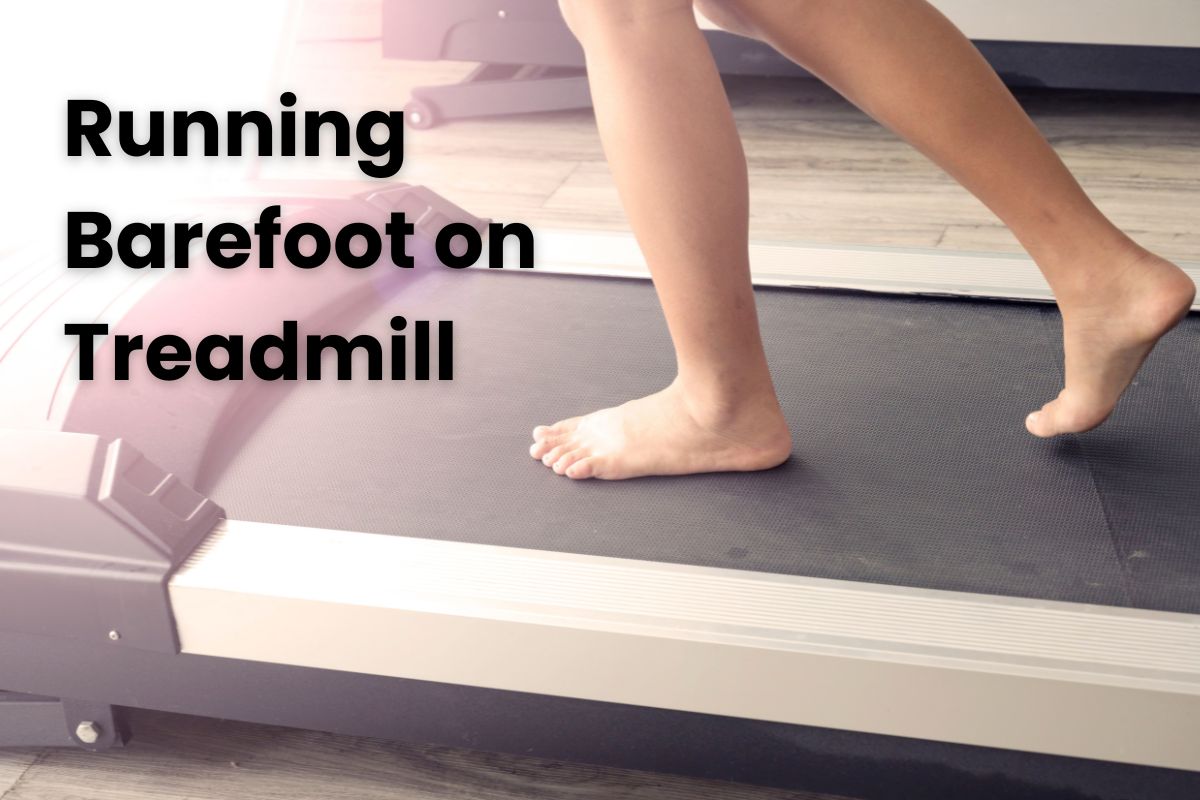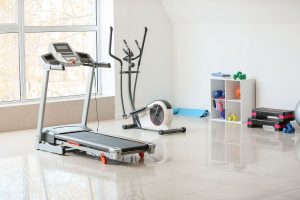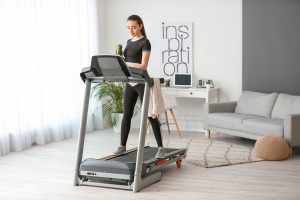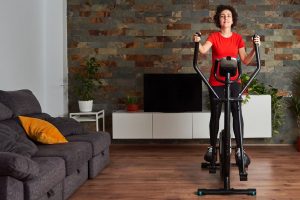
So, let’s picture a world where the boundaries of traditional running are shattered, where the thrill of the treadmill meets the untamed essence of your bare feet. It’s time for you to brace yourself for the new journey that will set your heart sheeny by running barefoot on a treadmill.
Running barefoot was a common scene among people in ancient times. However, modernization took the tradition away. But as time went by, cardio treatment picked up the barefoot running among communities in recent decades due to its potential benefits for foot health and overall fitness.
However, barefoot walking has been talked about a lot in recent times, but has anyone talked to you about barefoot walking on the treadmill? I think no and that’s why you’re here right?
So, don’t you want to know if running barefoot on a treadmill is okay? Is it safe or should you wear shoes while running? Will it work like acupuncture treatment if you don’t opt for footwear?
So stay with us, because in this blog we will explore the experience of running without shoes on a treadmill, the preparation required, proper technique, potential risks, and expert tips to ensure a safe and successful experience.
Table of Contents
The Growing Trend of Barefoot Running on Treadmills
So, Ladies and gentlemen, prepare to witness the rise of barefoot running on treadmills because this is getting mass popularity among people in recent times.
A few years back, Christopher McDougall’s bestseller book “Born to Run” swells the tendency of barefoot running again. It is also believed that the first marathon runner named Pheidippides, ran barefoot. Also in the US, there is a barefoot running society that has 1500 members.
However, running barefoot outside isn’t safe at all. There might be all types of glasses, gravel, and stones waiting for you to hurt your feet. So what’s the alternative?
Yes, you have the option of running barefoot on a treadmill. Because there you’ll get a controlled and safe environment and run on the smooth surface of the treadmill belt.
Trust me, in the grand theater of fitness, barefoot running commands the stage like a true star. According to statistics, the trend of running barefoot on a treadmill increased by 45% among gymgoers. Also, according to a study, it shows that running barefoot can change your biomechanics compared to shod running.
So, dear adventurer, dare to set on this dramatic journey. Because running barefoot on a treadmill is absolutely okay however you need to make a few adjustments.
4 Benefits of Running Barefoot on a Treadmill
So, my dear audience, let these four benefits mentioned below be your guiding stars on this thrilling journey.
1. Enhanced Foot and Ankle Strength
Barefoot running enhances your feet and ankle strength. When you shed the confines of traditional shoes, your feet and ankles awaken to a new state of strength and power. Since barefoot running activates your muscles immediately to stabilize your feet.
Whenever you run on shoes the support of the shoes creates weakness and imbalance in your feet. However, when you run barefoot this imbalance becomes more apparent and your feet work harder to make a balance. This ultimately enhances your feet ‘strength.
2. Improved Balance and Proprioception
Basically, the term proprioception describes the sensory information which contributes to the sense of position of self and movement.
When your feet connect directly with the treadmill’s surface, a symphony of harmony unfolds. Which creates a captivating dance of balance and proprioception.
With traditional running shoes, the artificial support often covers your body’s natural balance and proprioception. However, when you run barefoot on a treadmill all the artificial support sheds and your feet can receive sensitive information. Your body then adapts to the ever-changing terrain and cultivates a profound sense of balance. This basically improves the overall performance and also reduces the risks of injury.
3. Reduced Impact on Joints and Potential Injury Prevention
Running barefoot on a treadmill provides a drastic shift in the impact your joints experience, also reducing the risk of injuries.
When you run on a treadmill with shoes the hard surfaces of the shoes can make an impact on your knees, ankles, and hips, leading to discomfort and potential injuries. However, when you dare to step onto a barefoot running on a treadmill, your body naturally adapts to a more natural and gentle landing. And this symphony ultimately reduces the impact on your joints.
As your body gets used to this natural movement, then the risk of common running injuries like shin splints or stress fractures is also reduced.
4. Activate Sensory Receptors in the Feet
Basically, the sensory receptors are known as mechanoreceptors which are specialized nerve endings in your feet that detect pressure, stretch, and movement.
Running barefoot on a treadmill activates sensory receptors in your feet, creating a profound connection between your body and the surface you run on.
When you run without shoes, your feet make a direct connection with the treadmill’s surface. This allows the sensory receptors to come alive. Along with every step this receptor sends valuable feedback to your brain and also informs you about the surface and texture. This allows you to fine-tune your running technique.
How to Prepare Yourself for Barefoot Treadmill Running?
So, here are some experts tips for you to prepare yourself for barefoot treadmill running:
Evaluate Your Fitness Level and Suitability for Barefoot Running
Before starting running you make sure that you have a good level of general fitness and have no underlying foot or ankle issues that could be increased by barefoot running. If you’re unsure, consult a healthcare professional to get suggestions.
Transit From Traditional Running Shoes to Barefoot Running Gradually
So, if you are new to barefoot running, don’t go for the treadmill immediately. Take some time and allow your feet to acclimatize to the process. For this, you can practice barefoot in nature then after being acclimatized go for the treadmill. Only one or two minutes can be enough at the beginning level.
Select the Right Treadmill and Surface for Barefoot Running
Treadmills usually come in many variants. Among them, the top 3 variants are:
- Comfortable running belt texture
- Low heat production
- Deck suspension system
Among them, you need to pick a treadmill with a smooth and cushioned surface that reduces the impact on your feet. If possible, try to run on a rubber or softer surface rather than a hard surface to lessen the impact on your joints. Moreover, before starting to run, check the surface of the treadmill if there are any kind of sharp objects or anything that can harm you.
Maintain a spotless treadmill belt! Learn effective tips for cleaning and preserving your equipment’s longevity. Read our step-by-step guide now.
Proper Techniques for Barefoot Treadmill Running
Adjust Treadmill Settings for a Safe and Effective Workout
So, at first start with a slow speed and gradually increase the speed as you feel comfortable. Also, remember to avoid setting the treadmill at a steep incline initially since it creates extra pressure on your feet. Gradually increase the incline over time once you’ve become accustomed to barefoot running.
Land Softly and Maintain a Midfoot Strike
How you’re landing on the surface of the treadmill has a direct impact on your feet. So, ensure that you land on your midfoot, take little and light steps and run a bit behind where you normally stand on the treadmill to give proper space to the toes. Otherwise, you may be apt to face muscle soreness, particularly in the calves and feet.
Keep Proper Posture and Avoid Overstriding
Always remember to keep an upright posture with your chest lifted and shoulders relaxed. Also, try to avoid leaning too far forward or backward as it can disrupt your balance and gait.
Understand Gait Mechanics for Barefoot Running on a Treadmill
Make sure you familiarize yourself with the natural motion of your feet during barefoot running. For this, you need to start slowly and also need to pay attention to how your feet interact with the treadmill’s surface. Then adjust your stride and footprint according to your experience.
Potential Risks and Precautions
Indeed, running barefoot on a treadmill brings some potential risks, and taking proper precautions is essential to minimize the likelihood of injuries. Here are some potential risks and precautions to consider:
Impact on the Skin and Potential Blisters
Running barefoot on a treadmill can put more direct pressure on your feet, which may lead to skin irritation and blisters. Other than that, the treadmill surface usually becomes hot and rough. Moreover, the feet repeatedly meet the surface at the same point, creating more heat from friction. This can also create blisters on your feet.
On the other hand, You may feel that when we’re running with shoes we often get a better grip. Without any grip and support your feet might be at more risk of getting injured and face shin splints and plantar fasciitis.
Risks of Plantar Fasciitis and Stress
Running barefoot on a treadmill may increase the risk of conditions like plantar fasciitis,( an inflammation of the foot’s plantar fascia), and stress fractures due to the repetitive impact. This happens because while running your feet remain unprotected.
To reduce this risk, transition to barefoot treadmill running gradually and incorporate strength exercises to support your foot and lower leg muscles.
Importance of Listening to Your Body and Recognizing Signs of Discomfort or Pain
Always pay attention to the fact that how your body responds to barefoot treadmill running. If you experience persistent discomfort, problem, or any unusual sensations, stop the activity immediately. Take rest and consult a healthcare professional if necessary.
For this, you need to learn to differentiate between normal muscle soreness and potential injuries. Whenever you notice any kind of sharp pain, swelling, or any changes in your gait, take medical advice immediately.
Discover the ultimate in treadmill comfort! Explore our guide to find the treadmill with top-tier shock absorption, ensuring a joint-friendly workout experience.
Expert Tips for a Successful Barefoot Treadmill Running Experience
For a successful barefoot treadmill running experience, consider the following expert tips:
Warm Up and Cool Down Adequately
Before your barefoot treadmill running session always try to do warm-up exercises to prepare your muscles and joints.
Also remember, after completing the run, engage yourself in static stretching to cool down and improve flexibility.
Incorporate Strength and Flexibility Exercises to Support Barefoot Running
Some exercises target your foot, calf, and lower leg muscles to build strength and stability. Try to incorporate these activities.
Moreover, do work to improve your flexibility while exercising to reduce the risks of injuries. Because the more you get used to it the less you’ll get injured.
Pay Attention to Hygiene and Cleanliness While Running Barefoot
Ensure the treadmill’s surface is clean before starting your barefoot running session. For this, you need to know how to clean your treadmill belt. And try to follow those steps regularly. Also, wash your feet thoroughly after each run to prevent any kind of potential infections or skin issues.
Maximize your space with the perfect treadmill! Explore our top picks for low ceilings, combining compact design and high performance for effective home workouts.
Wrapping Up
Running barefoot on a treadmill can offer unique benefits for foot health and running performance along with foot and ankle strength, balancing skills, and sensory receptors as well as reduced impact on joints.
For getting these advantages you need to follow some proper preparation, technique, and safety precautions. Otherwise, you’ll have to face some consequences which you never wanted to.
And most importantly, remember to listen to your body, progress gradually, and seek professional advice if you have any concerns about your foot health. With caution and knowledge, barefoot treadmill running can be a valuable addition to your fitness routine.





